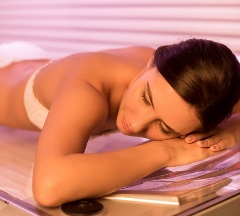Illuminating the Risk of Tanning Beds

Find Your Perfect Match
Answer a few questions and we'll provide you with a list of primary care providers that best fit your needs.
You probably know that exposure to the sun’s ultraviolet rays increases your risk of skin cancer. But are you at less risk of skin cancer when you retreat indoors to the lights of a tanning bed?
Whether you tan outdoors or indoors, you expose your skin to two types of UV radiation: UVA and UVB. Most of the rays from the sun are of the UVA variety. And both types can damage your skin and raise your risk of skin cancer.
UVA rays, long-wave radiation, penetrate the deeper layers of your skin, where most skin cancers develop. The UVA rays damage cells in the basal, or deepest, skin layer. This damage also causes skin to age and wrinkle.
UVB rays, which are shorter in wavelength, cause skin reddening and sunburn. They penetrate your skin’s outermost layers. Still, UVB rays play a role in skin cancer development, tanning and skin aging.
No matter how you tan – indoors or out – you increase your risk for skin cancer.
No Tan is a Safe Tan
The Skin Cancer Foundation reports that people who use tanning beds are 74 percent more likely to develop skin cancer than people who tan outdoors only.
The level of UV exposure varies in indoor tanning equipment, depending on the age and type of light bulbs used. But indoor tanning lights are designed to deliver high levels of UV radiation in a short time.
The rays emitted by indoor tanning equipment are unfiltered. Exposure to the UV light that comes from a tanning bed can be very harmful to the skin. It is as if you have unfiltered UV light, so the UVA and UVB, which is normally reduced somewhat by our atmosphere, is 100 percent able to reach the skin.
The Health Risks of Tanning
No matter how you tan – indoors or out – you increase your risk for
skin cancer. Indoor tanning and UV radiation can cause skin and eye damage and cancers including:
- Melanoma, the deadliest type of skin cancer
- Basal cell carcinoma
- Squamous cell carcinoma
- Cataracts
- Ocular melanoma
The Younger You Start, the Greater the Risk
Tanning remains most popular among young Caucasian women between ages 15 and 29, says the American Academy of Dermatologists. This group makes up 70 percent of tanning salon customers.
At the same time, melanoma is the second most common cancer in females in this age group. And the younger you begin tanning, the more likely you will develop skin cancer. Each exposure to UV radiation raises the risk.
That’s why it’s important to talk with your teen about the risks of tanning.
Find Your Perfect Match
Answer a few questions and we'll provide you with a list of primary care providers that best fit your needs.
Source: Skin Cancer Foundation; Centers for Disease Control and Prevention; American Academy of Dermatologists; American Cancer Society




